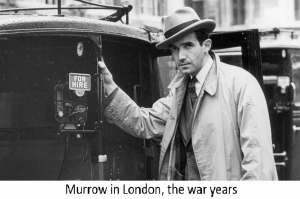
Edward R. Murrow was arguably the most famous person to hail from the Pacific Northwest corner of Washington State. Murrow was born in North Carolina in 1908, but his family moved to the Blanchard and Edison area in Skagit County in 1913. Egbert, that’s his actual first name, graduated from Edison High School prior to his enrolling at Washington State University and subsequently launching his phenomenal broadcasting career.

After Ed left the family home as a young man, his parents bought a house on 13th Street in Bellingham, WA. (house still standing). During the war and after, Ed would visit his parents, Ethel and Roscoe, and old timers have told me he would be seen driving around town in an automobile. When I was in high school, my Spanish teacher told of having met Ed Murrow many years before when they were both buying gas at a local service station.
In 1949, as part of one of his broadcasts from CBS in New York, Murrow pushed a button that lit Bellingham’s official city Christmas tree (the tallest in the nation at 153 feet). The next Bellingham Herald clipping, typical of the local paper’s coverage of Murrow’s upcoming visits, was published on Jan. 25, 1942. This visit took place less than two months after the Pearl Harbor attack that led to U.S. entry into WWII.

Personally, it was in the early 1990s that I began collecting historical radio broadcasts from the WW II years. This research took place long before the days of internet search engines. My material was gleaned directly from extensive study of historical texts, then making contact with potential sources in various countries and then crossing my fingers and hoping for favorable responses.
I discovered early on that many logical sources such as major networks and famous news correspondents of the era did not have copies of even their own pioneering broadcasts. Eventually I was able to supply rare audio tracks to the following: family of the late Edward R.Murrow; several of the then remaining Murrow Boys including Eric Sevareid (To read about Sevareid click HERE), William L. Shirer and Richard C. Hottelet); the BBC; the Dwight D. Eisenhower Presidential Library; and the academy award winning film “The English Patient.”

In hindsight, one of the bigger opportunities I overlooked in my life was an offer from Murrow’s immediate family to provide me with several boxes of the famous man’s old recordings that had been stored in the attic at his folk’s house. At the time the offer was made, I was selling my radio station, (KBFW-Bellingham) so I passed it off to a local state archive that displayed interest. Nothing ever happened in that regard and I don’t know where the old records ended up. Jeanette Coble, the Murrow family member who owned the recordings, passed away many years ago.

The first night of the blitz on London began September 7, 1940. The recording featured here is, in the opinion of historians, one of Ed’s most effective reports. I had read about the broadcast in history books, but it was not accessible for listening until I identified a copy deep in audio archives that included war time recordings from CBS affiliate KIRO in Seattle. I found out later that even Murrow biographers, who lauded this as a great report, had not heard it in Murrow’s own voice — they were analyzing written transcripts. In 2016, so this broadcast would not once again fade into obscurity, I placed this recording on YouTube.
In those early days of overseas news gathering, a correspondent would send a report back home to the network via shortwave radio. Often there was a delay (international time zones, scheduling, etc.) between when a report was received by a network and when it actually ran. Murrow’s story of the first day of the blitz aired in the U.S. on September 8, 1940, when in fact the air raid on London had taken place the day before.
Prior to his preparing this report, Murrow and two of his colleagues were outside the city, at a haystack near an airdrome, when the blitz unfolded before their eyes. The static and interference in the recording were typical of overseas shortwave radio broadcasts from the WW II era.
And That’s a Wrap!
Related: Click Here to learn about Lorne Greene, a pioneering Canadian network anchorman during WW II and later a famous actor in the U.S.
Click on any of the names below to read about popular Pacific NW broadcasters, including Canada’s legendary DJ Red Robinson:
Danny Holiday (KPUG)
Dick Stark (KENY & KPUG)
Kirk Wilde (KPUG)
Gary Shannon (KPUG)
Mike Forney (KPUG)
Jay Hamilton (KPUG & KBFW)
Bob O’Neil & Marc Taylor (KPUG)
John Christopher Kowsky (KPUG)
Haines Faye & Rogan Jones (KVOS & KGMI)
Tom Haveman (KENY & KVOS)
Red Robinson (Vancouver B.C.)
Presently editor and historical writer with QZVX.COM in Seattle. Former radio broadcaster and radio station owner, 1970-1999. Journalism and speech communications degrees. I enjoy researching articles and online reporting that allows me to meld together words, audio and video. P.S. I appreciate and encourage reader comments and opinions. View other articles by Steven Smith



COMMENT GUIDELINES | "What Happened To My Comment?" | post an OFF-TOPIC COMMENT